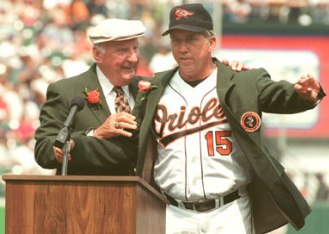This post will be more similar to the 3:3 post as opposed to the 1:3 posts. It is fairly difficult to determine who will definitely be available at this early date. It is also pretty difficult who the Orioles will value as Jordan's staff seems to follow the beat of their own drummer. I will try to identify an individual that might be available 118 players deep (round 4: pick 3). Stereotypical Jordan picks are projectable/low ceiling college position players, JuCo pitcher with potential, projectable/low ceiling left handed college pitcher, and prep pitchers with projection.
P/LC College Position Player
Andy Wilkins 1B/3B/RF University of Arkansas
Wilkins is playing most of his time at first base for Arkansas as Zach Cox mans third base and is the best collegiate first baseman in this year's draft. Wilkins is a fine player in his own right, but does not match the potential of Cox. He has a strong lefty power swing and may be able to profile at third base or right field. Range may ultimately be limiting in the outfield. He should be willing to sign for slot here at around 280k.
JuCo Pitcher with Potential
Jake Eliopoulos LHSP Chipola JC
Eliopoulos was drafted last year by the Blue Jays in the second round last year. He was considered a slight overdraft and required overslot. The Jays did not offer him as much as he wanted and he decided to go to Chipola. I do not think he increases his value much this year and with the shine off him, teams will see that the ceiling is lower than what some thought with him coming out of high school. He throws a fastball in the upper 80s with marginal command, his curveball looks incredibly promising, and his changeup is mentioned as being a work in progress. As a lefty, this is a good group of characteristics to have. He is not expected to put on much more velocity and will likely fall short of being a starter. The Orioles are a team that has made a significant push in the last year to acquire more left handed pitching in their minors and Eliopoulos is a guy whose floor is still usable to this organization. Being an eligible freshman, I could see him signing for about 350-400k.
P/LC College Pitcher
Kevin Gelinas LHP Junior University of California, Santa Barbara
Gelinas is primarily a two pitch pitcher with a fastball the crests 90 and a slider in the low 80s. This spring, a hurdles for him include getting greater command of his pitchers (his mechanics need a bit of refinement) and to actually throw changeups in game situations. A lefty at the velocity should certainly garner more attention than he did last year when he was selected at the end of the draft, but the lack of a viable third pitch for a Junior will keep him out of the first couple rounds. This type of player fits well for the Orioles as I previously mentioned. He is a lefty who has two decent pitches that may become average to above average at the pro-level. He would be a decent fit as a left handed bullpen prospect. If the change shows promise, he might be in line as a swingman or backend rotation pitcher at the pro level. That is good value for the fourth round. I imagine he would sign at slot here, 280k.
Prep Pitcher with Potential
Casey Mulholland RHP Pendleton HS FL
Mulholland is a tall lanky pitcher who has some projection left in his body. He has a fastball in the high eighties, a decent slow curve, and the working of a changeup. There certainly is a lot to be intrigued by his sets of skills and he could wind up being a legitimate starting candidate. Mulholland is definitely a player I will be following as the prep season progresses. He will probably be a slight overslot, but I doubt he is firmly committed to Ole Miss. I imagine around 320-360k would get him to pass on college.
Nothing after the jump.


















